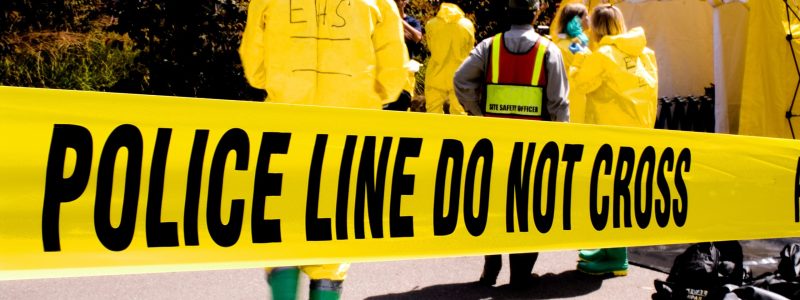Ensuring Law Enforcement Readiness: Essential Hazmat Training
The Importance of Hazmat Training for Law Enforcement Personnel
Law enforcement officers are often first on the scene and play a pivotal role in managing hazardous materials (Hazmat) incidents. Officers assist in initial assessments, scene security, and evidence collection, while also ensuring their own safety. Our training programs specifically designed for law enforcement personnel emphasize:
Protecting Yourself and Others
Officers must recognize potential hazards, such as chemical spills, toxic gases, or radiological threats. Signet’s training programs provide the knowledge to identify Hazmat indicators (placards, odors, or symptoms) and implement safety measures, such as establishing safe zones and using personal protective equipment (PPE).
Ensuring Public Safety
Officers are responsible for crowd control, directing evacuations, and securing perimeters to prevent public exposure. They need to be able to communicate effectively with the public during hazmat emergencies to reduce panic and ensure compliance with safety measures.

Multi-Agency Coordination
Hazmat incidents often involve multiple agencies, including fire departments, EMS, and environmental teams. Inter-discipline training enhances interagency communication, allowing law enforcement to provide critical information, enforce access controls, and maintain order at the scene and beyond.
Preparing for Unpredictable Threats
Officers may encounter diverse Hazmat scenarios, such as industrial and transportation accidents, illicit labs, chemical suicides, or intentional criminal releases. Training equips them with the tools to respond appropriately to chemical, biological, radiological, nuclear, and explosive (CBRNE) threats.
The Importance of Hazmat Training for Law Enforcement Personnel
Hazmat (Hazardous Materials) training is essential for law enforcement personnel for several reasons:
1 **First On Scene**: Law enforcement personnel are commonly among the first to arrive at incidents involving hazardous materials and oftentimes the least equipped from a hazmat perspective. While many associate hazmat response with large containers and quantities, it’s important to note that serious incidents can occur in everyday locations like garden centers, swimming pools, grocery stores, restaurants, and even schools and office buildings. While these places may use hazardous materials known to local responders, even private properties and vehicles can pose unknown and significant risks, particularly to law enforcement personnel who could be the first to discover alternative fuels vehicles (such as natural gas and electric which each present significant and very unique challenges), illicit labs, chemical suicides, suspicious packages, and others. In the past, hazmat-specific training was limited to specialized teams within large agencies and communities. Fortunately, this outdated approach is no longer the norm. It is vital for all emergency responders to receive comprehensive training tailored to their roles to safely and effectively manage potential hazmat situations.
2 **Effective Response and Containment**: Proper Hazmat training enables law enforcement officers to quickly and effectively help assess the situation, secure the area, and work in coordination with specialized Hazmat teams to contain the hazard and prevent it from spreading, thus reducing potential harm to the environment and the community.
3 **Legal and Regulatory Compliance**: There are strict regulations governing the handling of hazardous materials. Law enforcement personnel must be familiar with these regulations to ensure that they do not inadvertently violate them during a response, which could lead to legal consequences and further endanger public health.
4 **Interagency Coordination**: Hazmat incidents often require the collaboration of multiple agencies, including fire departments, emergency medical services, environmental protection agencies, and public health departments. Law enforcement officers with Hazmat training can effectively communicate and coordinate with these agencies, ensuring a more organized and efficient response.
5 **Preparedness for Terrorism and Criminal Activity**: In some cases, hazardous materials may be used deliberately in acts of terrorism or criminal activity. Hazmat training prepares law enforcement officers to recognize signs of such activities, manage the scene safely, and gather evidence without compromising their safety or the integrity of the investigation.

6 **Public Reassurance and Community Trust**: When law enforcement personnel are well-trained in hazardous materials response protocols, they can provide accurate information and guidance to the public during incidents. This helps to reassure the community and maintain trust in the authorities’ ability to manage dangerous situations.
In summary, Hazmat training is vital for law enforcement to ensure their own safety, protect the public, effectively respond to and contain hazardous situations, comply with legal standards, and coordinate with other agencies in a professional and effective manner.
Signet North America’s Hazmat For Law Enforcement program includes but is not limited to:
- Identifying hazmat scenes and ensuring officer and public safety
- Establishing effective scene control and investigation procedures
- Maintaining clear communication with other first responders (fire, EMS)
- Minimizing officer exposure and contamination risks
- Working in hazmat PPE
- Decontamination of personnel and equipment
Hazmat Response Training For Law Enforcement: The Signet Experience
Essential Role-Specific Skills
Hands-On Hazmat Training
Compliance and Safety
NFPA 470 Hazardous Materials Awareness and Operations
OSHA Series: Customized HAZWOPER
NFPA 470 Hazmat Highway Response
NFPA 470 Hazardous Materials/WMD Incident Commander
Hazmat Detection, Monitoring and Sampling
Evidence Preservation and Public Safety Sampling
Advanced Monitoring and Detection
Get Training Started Today
At Signet North America, we are committed to helping the industrial and factory industry navigate the complex world of hazardous materials management. With our tailored training solutions, practical approach, and expert guidance, we can help your facility build a culture of safety and preparedness that will protect your workers, your assets, and the environment. Contact us today to learn more about how we can support your hazmat training needs.
Start Your Training Today
Contact Signet for Training
Thank you for considering Signet North America for your hazmat needs. We are dedicated to providing exceptional service and support to our customers. Below are the various ways you can reach out to us!

